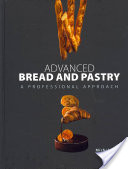My time and place at Noma
I often get the question “what type of restaurant is Noma really?”
It’s a very valid question from someone who has never been there, but perhaps has heard its billing as “the World’s best restaurant” and bastion of modern regional Nordic cuisine. I wrote a bit about the New Nordic cuisine concept in this other post.
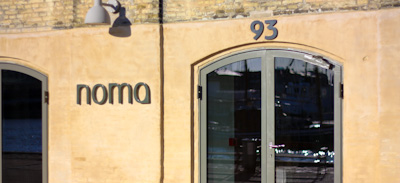
I usually summarize Noma as being as far from classic fine dining as any restaurant possibly could be. The restaurant itself is housed in an old 18th century whaling warehouse on the Copenhagen docks. The building has been brilliantly restored and now houses not only Noma, but also a center for art and culture of the whole North Atlantic region. This setting – the ancient waterfront trade dock is a beautiful one, although quite unpretentious in its simplicity.
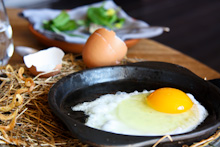 Once inside the restaurant; this place lets you experience a spectacle, an interactive performance more than a regular sit-down-and-be-fed-meal. There’s much more conversation between guests and staff, opinions are shared, questions are asked, facts are told. You may even be lucky enough to cook one of the dishes right at the table.
Once inside the restaurant; this place lets you experience a spectacle, an interactive performance more than a regular sit-down-and-be-fed-meal. There’s much more conversation between guests and staff, opinions are shared, questions are asked, facts are told. You may even be lucky enough to cook one of the dishes right at the table.
Something that started long ago at Noma and now is replicated in so many restaurants around the world is its chefs taking part in the food service. It’s a kind of evolution of the Japanese tradition where chefs directly serve guests sitting at the bar confining the kitchen. At Noma chefs leave their posts in the kitchen to bring the dishes to the table and in a calm and informative way explain its components and their origin. This creates a unique feeling of ownership and pride for the staff – and who could be better suited to answer questions about techniques or flavors than the chefs themselves? The service from the waiting staff is equally down-to-earth, honest and courteous and makes you feel comfortable in your chair.
Working in the kitchen
Early morning - The kitchen really starts rolling at 8:30 in the morning. Before that, only the AM team (starting before 6 am) dwells in the Noma galley. They fire up the Noma engine each day – executing many of the lengthy tasks in the kitchen; making fresh juices, toasts for the snack section, scraping chicken skin, blanching leeks and smoking eggs. At 8:30 there’s a wave of people hitting the kitchen – knives in hand. Everyone’s pulls out their respective ingredients, chefs instruct stagiaires, chopping boards are set up, and, in another corner of the kitchen, the eternal herb picking starts. (Throughout the four seasons, Noma uses roughly 100 different types of herbs, leaves, shoots and wild plants).
11:30 – Lunchtime briefing with the whole staff
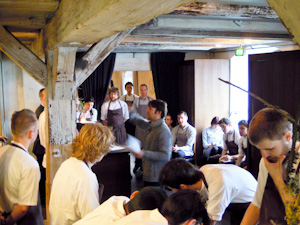 One of the most significant things that I will bring with me from Noma and implement in future positions, is the use of short briefings with the whole staff - chefs, waiters and stagiaires – before each service. Not many restaurants do this, but it’s a critical moment for the chefs and the waiters to snap up the latest facts – number of guests, arrival times, allergies, special requests and potential problems. From a stagiaire’s point of view it’s equally interesting and it makes you feel like a part of the team, au courant with the day’s happenings, and not just like an herb-picking robot.
One of the most significant things that I will bring with me from Noma and implement in future positions, is the use of short briefings with the whole staff - chefs, waiters and stagiaires – before each service. Not many restaurants do this, but it’s a critical moment for the chefs and the waiters to snap up the latest facts – number of guests, arrival times, allergies, special requests and potential problems. From a stagiaire’s point of view it’s equally interesting and it makes you feel like a part of the team, au courant with the day’s happenings, and not just like an herb-picking robot.
17:00 - The only real break during the long days is for staff meal (or family meal as it’s also called); 45 min of happiness, joy, amusement, relaxation and recharge. Everyone has their own ritual to get ready for yet another service. Someone spends 10 minutes eating and 30 minutes on the phone, another hurries out after the meal to have one, two, three cigarettes. A third tries to get a power-nap in his chair while another instead locks himself into the bathroom for some peace and quiet.
17:45 - The second pre-service staff briefing of the day.
“For a couple of hours, the guests eating in the restaurant are our very close friends” says René.
00:30 - Staff meeting, evaluating the day and presenting facts about tomorrow.
00:48 - Saturday night projects:
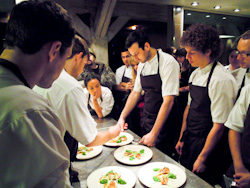 Every Saturday night, after dinner service, the mise en place is put away and the kitchen is cleaned. But, hold on, it’s not quite time to go home just yet. It is Project night - the chefs from the different sections of the kitchen present a dish of their creation to the rest of the staff, letting them taste it and in return receive feedback and thoughts. It’s a sort of incentive to be creative outside the daily work. It’s also a fabulous way to study how the other chefs think about food, how they manage to express themselves with food. Anyone is welcome to present a dish, chefs and apprentices, as well as stagiaires.
Every Saturday night, after dinner service, the mise en place is put away and the kitchen is cleaned. But, hold on, it’s not quite time to go home just yet. It is Project night - the chefs from the different sections of the kitchen present a dish of their creation to the rest of the staff, letting them taste it and in return receive feedback and thoughts. It’s a sort of incentive to be creative outside the daily work. It’s also a fabulous way to study how the other chefs think about food, how they manage to express themselves with food. Anyone is welcome to present a dish, chefs and apprentices, as well as stagiaires.
01:53 - Now that the day finally is over, the only thing that stands between work and the evening goodbye is the locker room. Here 40 people change before heading off home into the Danish night. Try putting all those shoes, used for more than 15 hours, in a small room together with chef’s jackets perfuming of fish, herbs and braising liquids. No surprise everyone is in a hurry!
The drive behind Noma
Fine dining in the modern meaning of the word, according to me, refers to the care with which the ingredients have been sourced and prepared in the kitchen, as well as the way the guests are cared for and the way the food is presented in the dining room. It’s not about white tablecloths, valet parking or waiters in tuxedos with fake smiles anymore.
Here I feel that the New Nordic cooking is setting a sort of standard with its low-key and minimalist approach to cooking and serving, still pushing the envelope in terms of ingredient quality.
But, this blessing of using only the best ingredients it’s not something that comes cheaply. It takes incredible amounts of time to source them 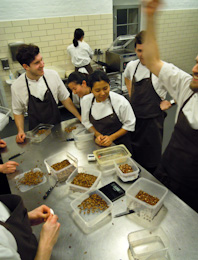 (at Noma one of the sous-chefs has the responsibility of keeping a good relationship with the nearly 100 suppliers, butchers, fishermen, and foragers).
(at Noma one of the sous-chefs has the responsibility of keeping a good relationship with the nearly 100 suppliers, butchers, fishermen, and foragers).
In wintertime it can be rather hard and sometimes even frustrating to try to find fresh and interesting ingredients. During the colder months the North seems to have a limited array of flavors, forcing you to work your creativity on what’s at hand. But as the old saying goes: “Seek and ye shall find” - and that is just what René and his team has done during many winters, finding both common and uncommon (but certainly edible) things.
Surely some ingredients or cuts of meat have raised eyebrows - like the live Danish fjord shrimps (eaten live. Yes, live.) and reindeer tongue. But ultimately these ingredients are not at all about producing a shocking effect. It all comes down to serving truly delicious food from the Nordic region and a wish to go your own way, being as far from “trendy” as possible.
Quite a few of the ingredients in the restaurant are served raw, or nearly. Somehow it would be a shame to modify the flavor of them too much over the fire.
Chef René often points out that if you know all about the origins of the produce you are cooking, maybe you’ve seen it grow or even picked it yourself; it’s harder to perform an unfair massacre on it in the kitchen. At Noma you learn to respect your ingredients in a unique way.
Staff
The common kitchen language is English since there are people from literally all over the world working here. Although I personally understand Danish, most of the people (I counted 15 different nationalities) do not – making English the obvious choice over Mandarin, Russian or Spanish.
In a place as big as Noma (with a staff of 60 or so persons) it’s imperative to have a smooth, collaborating and very hierarchically structured organization. A bit like a military squadron, orders running through the ranks in a well-ordered manner.
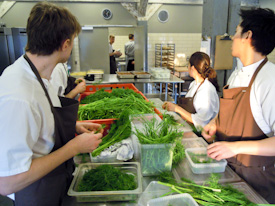 Another great strength at Noma is the pure number of workers. If anyone should run into trouble or unforeseen difficulties during preparations, there are always enough helping hands around to resolve any potentially bad situation.
Another great strength at Noma is the pure number of workers. If anyone should run into trouble or unforeseen difficulties during preparations, there are always enough helping hands around to resolve any potentially bad situation.
I must say I have rarely seen a kitchen with so much energy, a vibrating feeling from a constant adrenaline flow. So many people giving their all with a sole objective – to serve every guest a perfect and memorable meal—is truly unique. This is not always an easy task in the harsh environment of a professional kitchen. Everything is subject to rigorous inspection and any mistake is rectified immediately. Chefs must withstand plenty of stress, tough attitudes, and live up to first-class quality demands, all while serving the guests with a smile.
The chefs of different ranks sacrifice a lot for their job, even their spare time, offering their services as early as 6 o’clock in the morning to forage in parks and on beaches around Copenhagen. And finding time for partner or family can be quite hard. Many of the chefs at Noma are also far away from their home countries, which makes it even more difficult to keep these remote social contacts alive. Therefore you often end up spending even your free time with collegues – making work and social life blend into one.
Chef René Redzepi
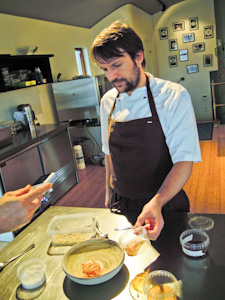 René was born in Copenhagen in 1977, son of a Danish mother and a Macedonian Muslim father. As a child he spent his summers in Macedonia (ex-Yugoslavia) with the family on his father’s side. They were living a traditional farm life, eating what they could grow and milking their own cows. This experience in southern Europe was of course much different to the life in Denmark in those years. It’s also something that has influenced the way he cooks and the way he approaches food nowadays. Growing up between two different cultural heritages has been a big advantage for Redzepi. When faced with Scandinavian ingredients he has been able to create a whole new way of cooking with them, without having hands tied by local traditions.
René was born in Copenhagen in 1977, son of a Danish mother and a Macedonian Muslim father. As a child he spent his summers in Macedonia (ex-Yugoslavia) with the family on his father’s side. They were living a traditional farm life, eating what they could grow and milking their own cows. This experience in southern Europe was of course much different to the life in Denmark in those years. It’s also something that has influenced the way he cooks and the way he approaches food nowadays. Growing up between two different cultural heritages has been a big advantage for Redzepi. When faced with Scandinavian ingredients he has been able to create a whole new way of cooking with them, without having hands tied by local traditions.
The Spanish gastronome and food critic Rafael García Santos said something special about Chef Redzepi during an event we attended in Spain. “Every time I eat in a new restaurant, anywhere in the world, I can always pin-point from which mentor the chef got his inspiration – with René I can’t! And this is a beautiful thing. I truly do not know where he gets his inspiration from.”
Well Rafael, let me tell you the answer to that question: From nature itself. That’s what is genius about him.
